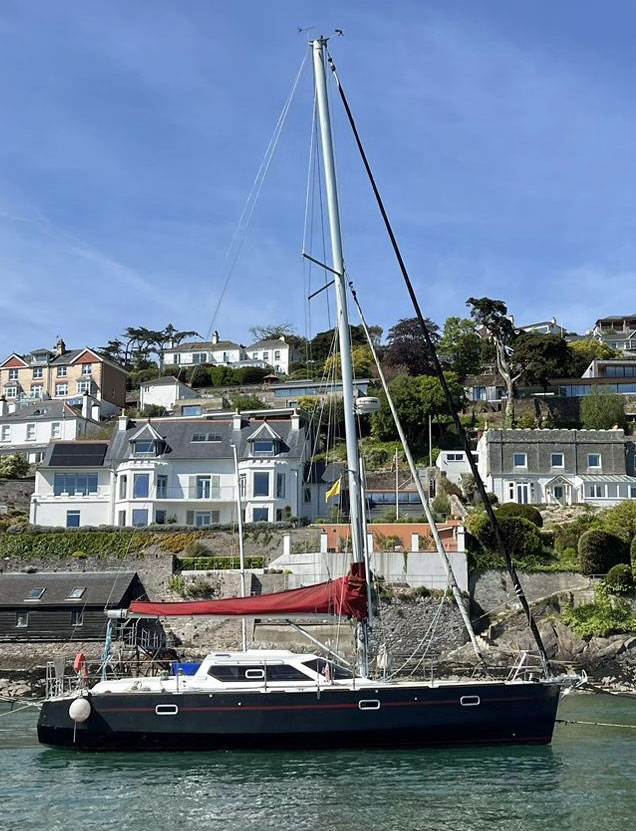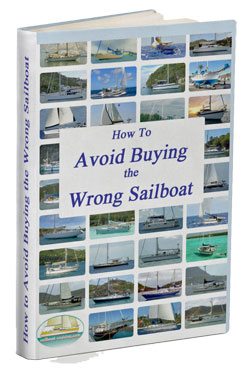- Home
- Cruising Yachts 30' to 35'
- RM-1050
The RM-1050 Sailboat
Specs & Key Performance Indicators
The RM-1050, a plywood-hulled cutter, was designed by Marc Lombard and built in France by RM-Fora Marine.
 Many thanks to owner John Taylor for this pic of his RM1050
Many thanks to owner John Taylor for this pic of his RM1050Published Specification for the RM-1050
Underwater Profile: Twin keel & spade rudder
Hull Material: Multi-chine plywood
Length Overall: 34'4" (10.5m)
Waterline Length: 32'2" (9.8m)
Beam: 13'0" (4.0m)
Draft: 5'3" (1.6m)
Rig Type: Cutter
Displacement: 10,362lb (4,700kg)
Designer: Marc Lombard
Builder: RM-Fora Marine (France)
Year First Built: 1998
Year Last Built: 2011
Published Design Ratios for the RM-1050
1. Sail Area/Displacement Ratio: 23.0
2. Ballast/Displacement Ratio: 38.3
3. Displacement/Length Ratio: 139
4. Comfort Ratio: 16.1
5. Capsize Screening Formula: 2.4
Summary Analysis of the Design Ratios for the RM-1050
1. A Sail Area/Displacement Ratio of 23.0 suggests that, in the right hands, the RM-1050 will have enough performance to leave most other sailboats of similar waterline length well astern.
2. A Ballast/Displacement Ratio of 38.3 would usually mean that the RM-1050 would have a tendency to heel uncomfortably in a gust, and need to be reefed early to keep her sailing upright in a moderate breeze.
However, as she has much of her ballast concentrated in the bulbs at the foot of her keels, she's likely to be considerably stiffer than her published Ballast/Displacement Ratio might suggest.
3. A Displacement/Length Ratio of 139, tells us the RM-1050 is clearly a light displacement sailboat. If she's loaded with too much heavy cruising gear her performance will suffer to a degree.
4. Ted Brewer's Comfort Ratio of 16.1 suggests that the RM-1050 will have the motion underway to that of a lightweight racing boat. Crew comfort will often be memorable for all the wrong reasons. Upwind in lively conditions the RM-1050 will slam enough to shake your fillings out with a motion that most cruising sailors have no desire to get used to.
5. The Capsize Screening Formula of 2.4 tells us that a RM-1050 would not be as good a choice of sailboat for ocean passage-making, owing to the increased risk of capsize in strong winds and heavy seas when compared to a sailboat with a CSF of less than 2.0.
More about the RM-1050
Accommodation
The RM-1050 sailboat has a spacious and bright interior with a large saloon, a galley, a chart table, a bathroom and two cabins. The fore cabin has a double berth with a length of 6’ 8” and a width of 5’ 2” at the head and 3’0” at the feet. The aft cabin has a maximum headroom of 6’ 1”. The saloon can also be converted into two additional berths. The boat can accommodate up to six people comfortably.
Sail Plan & Rigging Options
The RM-1050 sailboat has a cutter rig with a deck-stepped mast, two levels of spreaders and a 25° angle. The spars are made of aluminum and the standing rigging is 1x19 strand wire. The boat has a mainsail, a genoa, a jib and a symmetric spinnaker. The upwind sail area is 775 ft² and the downwind sail area is 1324 ft². The sail plan and rigging options are summarized in the following table:
- Mainsail 409 ft²
- Genoa 366 ft²
- Jib 172 ft²
- Spinnaker 915 ft²
Keel Options
The RM-1050 sailboat has two keel options: a twin keel version and a single fin keel version. The twin keel version has two asymmetric fins with bulbs that allow a shallower draft of 5’3” while maintaining performance. The twin keel version also enables beaching and stability on the ground. The single-fin keel version has one fin with a bulb and two spade rudders that provide more manoeuvrability and responsiveness. The single fin keel version has a deeper draft of 6’7”.
Sailing Performance
The RM-1050 sailboat is a fast cruising sailboat that has a light displacement, a high sail area to displacement ratio and a low comfort ratio. These ratios indicate that the boat is very high performing, especially in light wind, but also less comfortable and less suited for ocean passages than heavier and stiffer boats. The boat is best suited as a racing boat or a coastal cruiser that can handle moderate offshore conditions. The boat is stable and stiff thanks to the ballast in the bulbs of the keels but also needs to be reefed early to avoid excessive heeling. The boat has a good balance between speed and stability but also requires skill and attention from the crew.
The Designer, Marc Lombard
Marc Lombard is a French naval architect who has designed many sailboats for racing and cruising. Some of his sailboat designs are:
- RM: A range of plywood-epoxy cruising sailboats built by Fora Marine. They include the RM-890, RM-970, RM-1070, RM-1180, RM-1270 and RM-1370;
- Jeanneau Sun Odyssey: A series of fibreglass cruising sailboats built by Jeanneau. They include the Sun Odyssey 319, 349, 389, 410, 440 and 490;
- Jeanneau Sun Fast: A series of fibreglass performance sailboats built by Jeanneau. They include the Sun Fast 3200, 3300 and 3600;
- Catana: A range of carbon-infused catamarans built by the Catana Group. They include the Catana 42, 47, 50, 53, 59 and 70;
- Bali: A range of innovative catamarans built by the Catana Group. They include the Bali 4.0, 4.1, 4.3, 4.5, 4.6, 4.8 and 5.4.
Cruisers' Questions about this Sailboat...
What are the advantages of the twin keel configuration?
What are the advantages of the twin keel configuration?
The twin keel configuration allows the RM-1050 to have a shallower draft while maintaining performance thanks to the asymmetric fins with bulbs. It also enables the boat to beach easily and stably.
What is the HN rating of the RM-1050?
What is the HN rating of the RM-1050?
The HN rating or "Handicap Nationale" is an empirical rating system used in France to compare the relative speed of different monohulls. The RM-1050 sailboat has an HN rating of 24, which indicates that it is faster than most other sailboats of similar size and design.
What is the CE design category of the RM-1050?
What is the CE design category of the RM-1050?
The CE design category indicates the ability to cope with certain weather conditions according to the European Union standards. The RM-1050 sailboat has a CE design category of A, which means it can handle wind force up to 9 and waves up to 10 m.
The above answers were drafted by sailboat-cruising.com using GPT-4 (OpenAI’s large-scale language-generation model) as a research assistant to develop source material; to the best of our knowledge, we believe them to be accurate.
Recent Articles
-
Albin Ballad Sailboat: Specs, Design, & Sailing Characteristics
Jul 09, 25 05:03 PM
Explore the Albin Ballad 30: detailed specs, design, sailing characteristics, and why this Swedish classic is a popular cruiser-racer. -
The Hinckley 48 Sailboat
Jul 09, 25 02:44 PM
Sailing characteristics & performance predictions, pics, specifications, dimensions and those all-important design ratios for the Hinckley 48 sailboat... -
The Hinckley Souwester 42 Sailboat
Jul 09, 25 02:05 PM
Sailing characteristics and performance predictions, pics, specifications, dimensions and those all-important design ratios for the Hinckley Souwester 42 sailboat...













